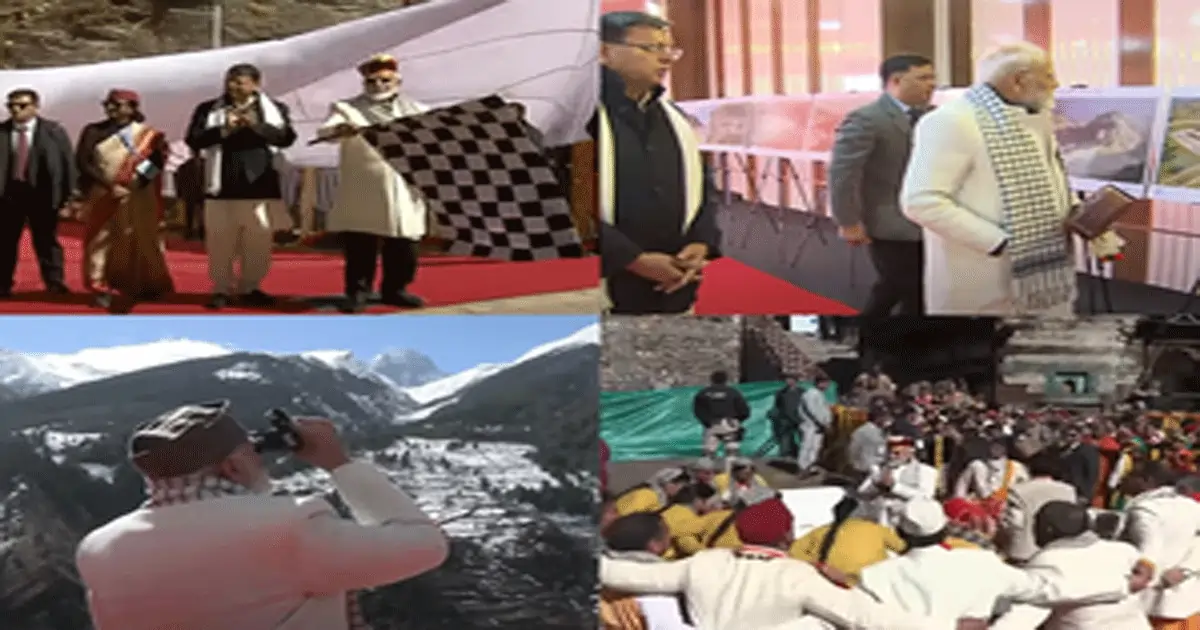National News
PM Modi visits Uttarakhand winter tourism exhibition in Harsil

Harsil, March 6: Prime Minister Narendra Modi on Thursday visited an ‘Uttarakhand Tourist Winter Tourism’ exhibition in Harsil, where he explored the state’s breathtaking destinations and cultural heritage.
The exhibition featured renowned sites, including Mahasu Devta, Timmarsain Mahadev Cave, Bala Sundari Temple, Tehri’s paragliding hotspot, Golju Temple, and Kartik Swami Temple.
The Prime Minister was briefed about the significance and unique aspects of these locations.
He also visited an exhibition under the ‘One District, One Product’ initiative, which aims to support local entrepreneurs and promote indigenous Uttarakhand products.
The exhibition showcased traditional attire, Baal Mithai, honey, Buransh juice, handcrafted shawls, and caps. The Prime Minister also witnessed a vibrant folk dance performance, celebrating the rich cultural heritage of the state.
Later, PM Modi flagged off a trek to Janak Taal and launched a bike rally from Harsil Valley, marking another step in Uttarakhand’s winter tourism push.
The visit aligns with the Uttarakhand government’s Winter Tourism programme, which has already attracted thousands of devotees to the winter seats of Gangotri, Yamunotri, Kedarnath, and Badrinath.
The initiative is designed to promote religious tourism while simultaneously boosting local businesses, including homestays and tourism-related ventures.
Earlier in the day, upon his arrival in Mukhwa, the Prime Minister visited the Mukhimath Temple, revered as the winter abode of River Ganga in the Uttarkashi district. He performed rituals and sought blessings from Goddess Ganga as hundreds gathered to welcome him.
Every year, on Diwali, the idol of Goddess Ganga from the Gangotri Temple is moved to Mukhimath Temple due to extreme winter conditions. The idol remains there for six months until the Gangotri Temple reopens in the summer, at which point it is taken back in a grand celebratory procession.
A day ahead of his visit, the Cabinet Committee on Economic Affairs (CCEA), chaired by PM Modi, approved two significant ropeway projects in Uttarakhand.
The first, a 12.9 km ropeway from Sonprayag to Kedarnath, will be constructed at a capital cost of Rs 4,081.28 crore under the Design, Build, Finance, Operate, and Transfer (DBFOT) model. The second, a 12.4 km ropeway connecting Govindghat to Hemkund Sahib Ji, has been approved for Rs 2,730.13 crore.
According to the CCEA, these projects will enhance last-mile connectivity for pilgrims while generating substantial employment during the construction and operational phases. The ropeways are also expected to drive socio-economic growth, benefiting industries such as hospitality, travel, food, and tourism.
With these initiatives, Uttarakhand is set to emerge as a year-round religious and adventure tourism destination, reinforcing its position as a spiritual and natural retreat.
Business
Gold and silver bring cheers for investors, 2026 outlook remains strong

Mumbai, Dec 25: In a year marked by heightened global uncertainty, precious metals delivered exceptional returns for investors, with silver emerging as a surprise winner.
Silver prices surged by more than 137 per cent — outperforming gold — which also posted a strong gain of around 68 per cent this year.
With equity markets facing volatility, both metals strengthened their position as preferred safe investment options, but silver clearly outshone all traditional choices.
Gold’s strong performance was supported by geopolitical tensions, inflation concerns, and expectations of interest rate cuts by the US Federal Reserve.
A major driving force behind gold’s rally was steady buying by global central banks. For three consecutive years — 2022, 2023 and 2024 — central banks have purchased more than 1,000 tonnes of gold each year.
Alongside this, global investors continued to invest through gold ETFs, using them as a safe place to park funds.
Big global banks have turned increasingly bullish on gold’s outlook. Goldman Sachs has raised its 2026 year-end gold price target to $4,900 per ounce, citing strong central bank demand and ETF inflows.
Deutsche Bank has also upgraded its outlook, projecting gold prices at $4,450 per ounce in 2026.
Silver’s rally, however, has been driven by more than just safe-haven demand. Strong industrial usage has played a crucial role.
Growing demand from sectors such as solar power, electric vehicles, and electronics has significantly increased silver consumption.
At the same time, supply constraints have tightened the market, pushing prices sharply higher.
This dual role — as a precious metal and an industrial input — has helped silver deliver more than double the returns of gold in 2025.
Looking ahead, experts believe the positive momentum in silver could continue into 2026.
Market specialists say that strong industrial demand, limited supply, and supportive global trends could help silver rise by another 15 to 20 per cent next year.
Some analysts expect that in the first half of 2026 alone, silver may generate an additional 20 to 25 per cent return from current levels, though they advise investors to invest gradually, especially if prices see short-term corrections.
Gold’s outlook also remains positive for 2026. Continued central bank buying, possible US rate cuts, and ongoing geopolitical risks are expected to support prices.
Analysts suggest that keeping an eye on central bank activity — whether they continue buying, hold their reserves, or start selling — will be critical, as their actions often signal future price trends well in advance.
“With uncertainty still dominating the global economic landscape, precious metals are likely to continue playing an important role in investor portfolios, offering a mix of safety and growth potential,” experts stated.
Meanwhile, both metal’s prices climbed to new record highs on the MCX on Wednesday morning, helped by a weak US dollar and expectations that the US Federal Reserve may cut interest rates further.
Gold futures for February rose 0.42 per cent to touch an all-time high of Rs 1,38,469 per 10 grams. Silver futures for March jumped nearly 2 per cent to hit a fresh record of Rs 2,23,742 per kg.
In the global market, gold prices crossed the $4,500 per ounce level for the first time. The rise was driven by strong demand for safe-haven assets as investors expect more interest rate cuts by the US Federal Reserve next year.
National News
Delhi HC asks DDA, MCD to act against illegal cafes, restaurants in Majnu Ka Tila, New Aruna Nagar

high court
New Delhi, Dec 24: The Delhi High Court on Wednesday directed the Delhi Development Authority (DDA), Municipal Corporation of Delhi (MCD) and the city government to take action against cafes, bars, nightclubs, restaurants and hotels operating in Majnu ka Tila and New Aruna Nagar without sanctioned building plans and in violation of safety norms.
A Bench of Chief Justice Devendra Kumar Upadhyaya and Justice Tushar Rao Gedela was hearing a public interest litigation (PIL) flagging concerns over unauthorised commercial establishments functioning in multi-storey buildings along the Yamuna river bank.
The plea sought directions to inspect and act against cafes, hotels and restaurants running without requisite permissions and sanctioned building plans.
It also urged the Delhi High Court to direct the MCD and the Delhi Fire Services to enforce the National Building Code and applicable fire safety measures in the area.
During the hearing, counsel appearing for the DDA informed the CJ Upadhyaya-led Bench that a suo motu complaint has already been registered on the portal of the special task force.
Taking note of the submission, the Delhi High Court disposed of the plea, directing the authorities to take appropriate action under law after reviewing the grievances raised by the petitioners.
“In view of the fact that a suo motu complaint has already been registered by the DDA, we dispose of the petition with a direction to the authorities to take appropriate action which may be warranted under law,” ordered the CJ Upadhyaya-led Bench.
It further directed the civic authorities to take action with expedition, preferably within three months. During the hearing, the Delhi High Court orally remarked that “half of the Delhi University students are there”, urging the authorities to ensure timely action.
In a lighter vein, CJI Upadhyaya observed, “Except the momo cart, everything shall be removed.”
The PIL highlighted that several structures in Majnu Ka Tila and New Aruna Nagar rise to “7–8 floors, with illegal basements, rooftops, and recreational facilities,” contending that the “structural and operational conditions of these buildings create an immediate and life‑threatening hazard.”
The petitioners claimed that most buildings lack staircases beyond the third or fourth floor, leaving “only small, low‑capacity lifts as vertical access.”
Where staircases do exist, they are allegedly “narrow, unlit, and poorly maintained,” and several terraces or rooftops are blocked or enclosed, leaving visitors without any effective evacuation route.
Referring to a recent tragic nightclub fire in Goa, the plea cautioned that it serves as “a stark warning of what could occur in similar circumstances”.
Crime
Two held with heroin worth Rs 1.5 crore in major drug bust in Delhi

New Delhi, Dec 24: In a major crackdown on drug trafficking, the Anti-Narcotics Cell of Delhi Police’s Outer North District has arrested two alleged drug peddlers and recovered 304 grams of fine-quality heroin, valued at around Rs 1.50 crore in the international market, officials said on Wednesday.
The seized contraband falls under the “commercial quantity” category under the Narcotic Drugs and Psychotropic Substances (NDPS) Act.
According to police, the arrests were made on December 21 following a specific tip-off about the movement of drug traffickers in the Narela area.
Acting swiftly on the information, a special raiding team was constituted under the leadership of Inspector Gaurav Choudhary, in-charge of the Anti-Narcotics Cell, and under the guidance of ACP Dinesh Kumar.
The operation was conducted under the supervision of DCP Outer North District Hareshwar Swami, IPS, and overall leadership of Joint Commissioner of Police, Northern Range, Vijay Singh, IPS.
“On conducting the search of their Vehicle (Shine Motorcycle bearing no. DL 5S CX 4), 304 grams of fine quality of Heroin (Commercial quantity) was recovered,” the police said in its press note.
The two accused have been identified as Taslim (23), a resident of New Seemapuri, and Salman Ansari (29), also a resident of New Seemapuri.
Taslim is a driver by profession and is reportedly a drug addict who has been involved in supplying narcotics for a considerable period. Salman Ansari, a tailor by profession, is a repeat offender and has previously been booked under the NDPS Act, police said.
Following the recovery, a case was registered at Police Station Narela under FIR No. 867/25 dated December 21, 2025, under Sections 21, 25 and 29 of the NDPS Act. Both accused were arrested on the spot, and the motorcycle used for transporting the contraband was also seized.
“Both accused persons are currently in custody, and further investigation of the case is going on to dismantle the “backward and forward” linkages of this supply chain to identify the kingpins and distributors involved in this syndicate,” said DCP Hareshwar Swami.
-

 Crime3 years ago
Crime3 years agoClass 10 student jumps to death in Jaipur
-

 Maharashtra1 year ago
Maharashtra1 year agoMumbai Local Train Update: Central Railway’s New Timetable Comes Into Effect; Check Full List Of Revised Timings & Stations
-

 Maharashtra1 year ago
Maharashtra1 year agoMumbai To Go Toll-Free Tonight! Maharashtra Govt Announces Complete Toll Waiver For Light Motor Vehicles At All 5 Entry Points Of City
-

 Maharashtra1 year ago
Maharashtra1 year agoFalse photo of Imtiaz Jaleel’s rally, exposing the fooling conspiracy
-

 National News1 year ago
National News1 year agoMinistry of Railways rolls out Special Drive 4.0 with focus on digitisation, cleanliness, inclusiveness and grievance redressal
-

 Maharashtra1 year ago
Maharashtra1 year agoMaharashtra Elections 2024: Mumbai Metro & BEST Services Extended Till Midnight On Voting Day
-

 National News1 year ago
National News1 year agoJ&K: 4 Jawans Killed, 28 Injured After Bus Carrying BSF Personnel For Poll Duty Falls Into Gorge In Budgam; Terrifying Visuals Surface
-

 Crime1 year ago
Crime1 year agoBaba Siddique Murder: Mumbai Police Unable To Get Lawrence Bishnoi Custody Due To Home Ministry Order, Says Report












